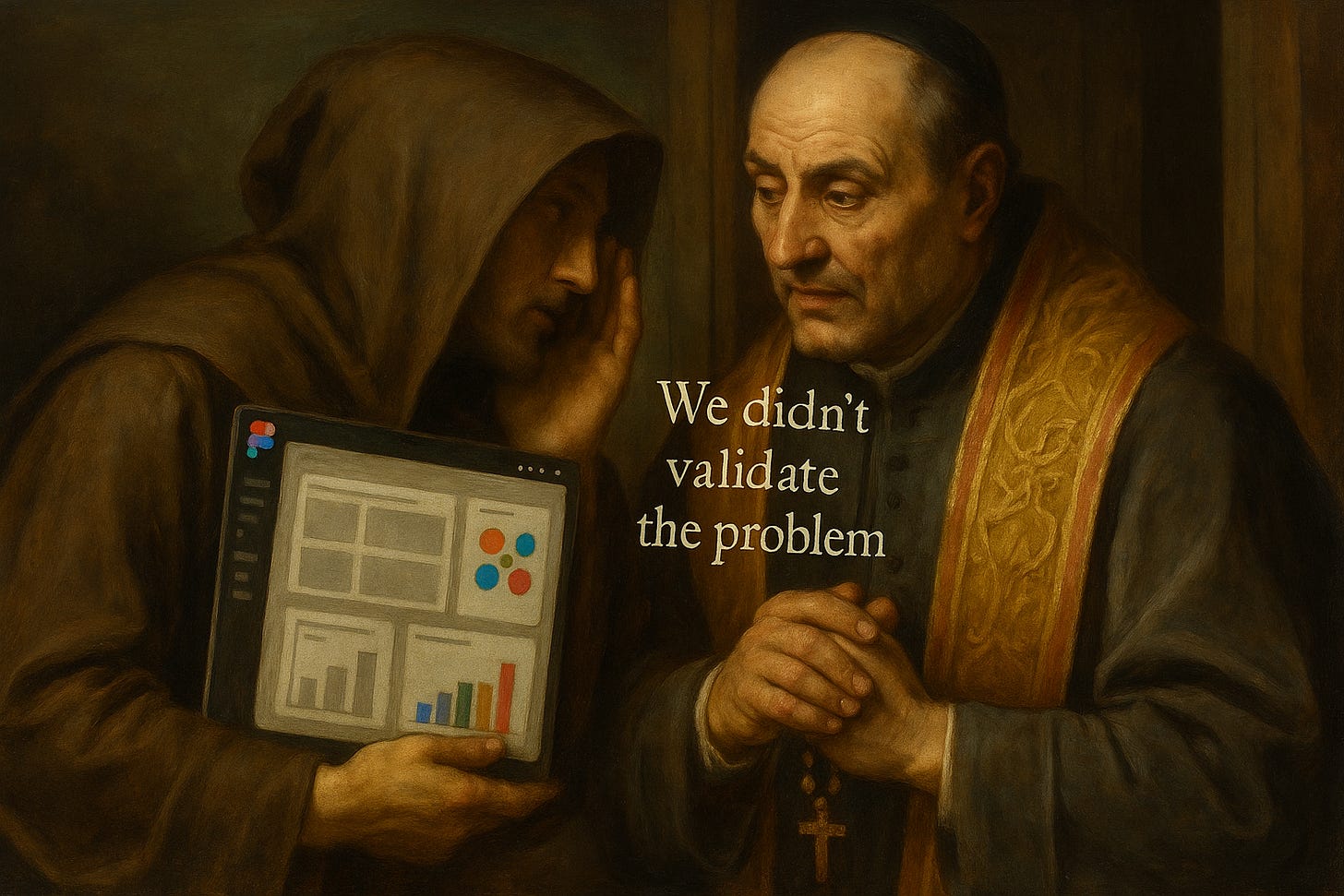The “Shiny Hammer” Syndrome
The hidden cost of building before you understand the why
Let me tell you about a startup. Let’s call them ClarityNest. Based somewhere between the co-working cafés of Nairobi and the pages of Notion. Eleven brilliant humans and a few AI agents. One shared vision:
to “elevate asynchronous workflow alignment via neural-integrated scheduling intelligence.”
Nobody knew what that meant, including half the team. But boy, did it sound VC-ready.
They spent ten months in build mode. The frontend was smooth. The beta logo had three design sprints of its own. Their onboarding animation was so fluid it made grown product managers weep for joy. And of course, it had dark mode. And “super-dark mode.” For the night owls who code in caves.
When launch day came, the party had custom cupcakes shaped like calendars. ClarityNest trended on Hacker News. Then… crickets. Users bounced. Retention charted a perfect ski slope. Even the founders quietly switched back to Google Calendar.
One angel investor reportedly muttered, “This is the most beautiful answer to a question no one asked.”
That’s when it hit them:
They’d built a perfect tool… for a perfectly fake problem.
Tool-First Thinking: The Most Expensive Hobby in Tech
Somewhere between the first sketch on a whiteboard and the 47th Figma comment, something quietly slips away. Teams forget. They forget why they started. They forget who they’re building for. They forget that software at its core isn’t an aesthetic exercise. It’s supposed to do something.
But hey! Building feels amazing, doesn’t it?
Pushing code to production feels like progress. Designing a slick UI? That’s art. Devops? Now you’re basically Tony Stark assembling the Avengers.
There’s dopamine in delivery, validation in velocity. Tools like Jira and Linear turn “bullet points” into sprints, epics, and burn-downs. Before long, everyone’s talking about components, scalable stacks, and “Phase 3 of the rollout plan.” The machine is humming. The office Slack is alive with screenshots and emojis.
But while the team is busy setting up their perfect system, the actual problem is quietly sulking in a Google Doc titled “Initial User Research – 6 Months Ago (Final FINAL v3).” (You know the one).
The truth? Real problems are messy. They hide in vague customer complaints, awkward silences in Zoom calls, and bug reports submitted by people using your tool in completely unintended ways. They live in legacy processes, undocumented workarounds, and Excel formulas that should be classified as dark magic.
They are not glamorous. They do not care about your design system. They will not clap for your accessibility toggle or liquid glass nav bar. And yet, they’re everything.
But the problem-space work is slow. It’s emotional. It requires interviews. Patience. Empathy. Sometimes, it requires realizing you don’t have a market-fit product, you have product-team infatuation. And that hurts. Because by now, you’ve already built. You’ve already pitched it. So instead, you keep going. You keep building. You add a dashboard. Then a filter. Then a chatbot. Then a chatbot with filters. Until one day, usually in a sprint, someone squints at the mirror and asks:
“Wait… why are we even building this again?”
And the room goes quiet. Not because no one knows the answer. But because they thought they did… Until that moment.
How to Fall in Love With the Problem, Not the Tool
Because users don’t care about your tech stack…they care about their headache. Let’s start with a mildly offensive idea:
You probably don’t need the tool yet. You need clarity.
That next sprint? Pause it. The fancy no-code builder you just paid for? Chill. Your five-year roadmap? Torch it (or at least print it on recycled paper first). Before you build anything…anything, you need to make sure you’re solving something real. Not “real in a brainstorm,” real. Not “I read a Medium post about it”, real. We mean “someone-is-duct-taping-a-spreadsheet-to-survive” kind of real.
How do we love the problem?
Talk to Real Humans (User-centric research): Wild, right? But seriously, have actual conversations. Ask what frustrates them. Watch them work. Note where they sigh, swear, or start talking to their screen. If no one's hacking together a workaround or complaining, chances are they’re not desperate for a solution. And if they’re not desperate, they definitely won’t pay, stay, or care.
A Prototype can be made out of anything: Can your big idea be tested with a simple Power App? A Google Form and automation? Notion? Good. Try that first. Because if it can’t work in the simplest, laziest form… No amount of code is going to save it from itself.
Stop Worshipping the Prototype: A working prototype is a milestone, yes. But it’s also a fancy way of saying: “Look, the idea works!” But value? Value comes from someone saying, “Thank God you fixed this. I was losing my mind.” Feedback is valuable.
The Sanity Test: A Framework Before You Ship
The Sanity Test is a fast, brutally honest way to figure out whether your product idea is worth building, or just a beautifully coded distraction.
It helps you:
Cut through the hype. Because “AI-powered synergy dashboard” sounds cool until no one needs it.
Validate urgency. If people aren’t suffering, they’re not searching.
Focus your energy. No more guessing. You’ll know if it’s time to build, test, or just quietly walk away.
Avoid expensive dead ends. Code is costly. So is your time. Sanity first, features later. The Sanity Test stops you from being the team that builds a ski lift in the Sahara and then wonders why nobody’s buying tickets.
Let’s End With an Unsolicited Pep Talk
So before you sprint into your next “Disruptive” product, take a deep breath. Ask the uncomfortable questions (Even if it makes everyone cry “Stop!“ in the room). Run the Sanity Test. Talk to humans. Hunt for the actual headache, not the hypothetical one you dreamed up in a brainstorm with too much coffee.
Because in the end, it’s not about building fast. It’s about building what matters. And if no one would cry if your product disappeared tomorrow? Well... maybe don’t spend the next six months polishing that onboarding animation.
Got a product idea? Run it through the Sanity Test™. If it passes, build it. If not, congratulations, you just saved yourself a sprint cycle and a therapy bill. Now go find a real problem and make something someone would actually miss.








I need to share this with my founders’ groups!! This should be a paid masterclass.
Thank you for sharing 💚💚💚